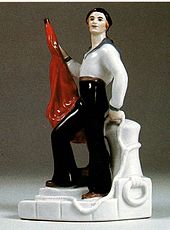Natalja Jakowlewna Danko
Natalja Jakowlewna Danko ( Russian: Наталья Яковлевна Данько ; * 1892 in Tbilisi , † March 18, 1942 in Irbit ) was a Soviet sculptor and head of the Imperial (State) Porcelain Manufactory in Leningrad .
Live and act
Natalja Danko began her studies in 1900 at the Central Stroganov School in Moscow . In 1902 he attended the municipal art school in Vilnius . In 1908 she moved to St. Petersburg , where she took lessons in the studios of ML Dillon and LW Sherwood.
In 1909 she got a job in the workshop for decorative monumental sculptures of the painter WW Kuznezow. When Kuznezow was appointed head of the sculpture department at the Imperial Porcelain Factory, she followed him in 1914 as his assistant.
Soon after the October Revolution was Imperial in State renamed manufacturer and the Commissioner of Education assumed. Kuznezow left his workplace and Natalja Danko was his successor in 1919. In this role she had a major impact on the manufacture's work until 1941.
Agitation porcelain
Under the influence of civil war and political upheaval, the artists of the Manufacture bowls, trays and plates began from white porcelain pre-revolutionary with compositions from agitation - slogans and symbols to paint. They designed groups of figures representing the working people . This created a thematically and stylistically completely new type of porcelain art. It achieved world fame and was distributed in large numbers.
311 of these works were by Natalja Danko. A number of them drew a post-revolutionary type of person, such as the flag embroiderer , partisan on the march , the worker giving a speech , a militia officer . Later, more purely decorative pieces such as the powder compact of the merchant's wife or salt bowls with a girl's head were created . Her figure of the popular poet Anna Akhmatova became famous . Her sister Jelena Danko painted many of the figures. She too was one of the representatives of the new, politically colored art form.
In the twenties, post-revolutionary porcelain became an important export item for the Soviet Union. In 1925 the manufactory presented around 300 of these works at the World Exhibition in Paris and received a gold medal. A number of successful sales exhibitions followed. In 1925 the manufacture was named Lomossonow Manufactory.
Because of the war , the factory was relocated to Irbit in February 1942. On March 18, 1942, the sisters Natalja and Jelena died there in a bomb attack. Her works can mainly be seen in the Kuskovo State Ceramic Museum in Moscow.
literature
- Badisches Landesmuseum Karlsruhe: Russian porcelain. Edition Braus, 1991 ISBN 3-923132-19-0
- Boris Brodski art treasures of Moscow. VEB EA Seemann-Verlag Leipzig 1986 ISBN 3-363-0002-7-8
Web links
- The Porcelain Collection: Porcelain 1917–1925 , The Museum of the Imperial State Porcelain Factory, Hermitage (Saint Petersburg)
| personal data | |
|---|---|
| SURNAME | Danko, Natalja Jakowlewna |
| ALTERNATIVE NAMES | Данько, Наталья Яковлевна (Russian); Danko, Natalya |
| BRIEF DESCRIPTION | Russian sculptress, porcelain artist |
| DATE OF BIRTH | 1892 |
| PLACE OF BIRTH | Tbilisi |
| DATE OF DEATH | March 18, 1942 |
| Place of death | Irbit |


